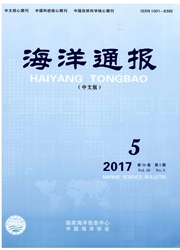

 中文摘要:
中文摘要:
利用象山港(2010年4月)、三门湾(2010年3月)及乐清湾(2009年4月)平水期的调查资料,分析讨论了不同类型的港湾水体营养盐的分布和行为特征。发现象山港具有3个港湾中最高浓度的PO43-和NO2-,分别为1.87和1.22μmol/dm3,三门湾则具有最高的NO3-浓度(61.0μmol/dm3)。三门湾的NO3-/PO43-比值高达43.0,其次是乐清湾(32.4)和象山港(27.5),水体富营养化特征明显。3个养殖港湾SiO32-浓度均与盐度之间呈显著的负相关,表明在混合过程中均呈保守行为,这与硅酸盐的天然来源和港内较弱的生物吸收有关。乐清湾NO3-与盐度之间存在一定的相关关系,而象山港和三门湾NO3-在混合稀释过程则表现为不保守,此外三门湾和乐清湾PO43-均表现为不保守行为,这主要由于NO3-和PO43-多样的人为来源和复杂的转移机制。另外,NO3-/SiO32-比值随盐度的变化表明象山港和三门湾在咸水端则均有较明显的硝酸盐输入,显然来源于海水养殖自身污染,水产养殖对海域氮和磷的负荷具有较显著的贡献。
 英文摘要:
英文摘要:
The distribution and behavior characteristics of nutrients in the Xiangshan Harbor, the Sanmen Bay and the Yueqing Harbor were discussed based on surveys performed in river level period. The highest concentrations of PO43-and NO2-were found in the Xiangshan Harbor with mean values of 1.87 and 1.22μmol/dm3, respectively, while the Sanmen Bay had the highest NO3- concentration with the average value of 61.0μmol/dm3. Meanwhile, NO3-/PO43- ratio in these three harbors were up to 43.0 (the Sanmen Bay), 32.4 (the Yueqing Harbor) and 27.5 (the Xiangshan Harbor) respectively,suggesting highly eutrophication in their aquatic environments. The correlation analysis suggested that SiO32- was significantly negatively correlated with salinity, suggesting conservative behavior of silicate during mixing, which could attribute to natural sources of silicate and weak biological uptake in inner harbors. In contrast, nitrate in the Xiangshan Harbor and the Sanmen Bay and phosphate in the Sanmen Bay and the Yueqing Harbor showed non-conservative behavior, which mainly linked with variety of anthropogenic input and complex biogeochemical processes of NO3- and PO43-. Additionally, the increase of NO3-/SiO32- ratio with the increase of salinity indicated excess nitrate input from aquaculture pollution in the Xiangshan Harbor and the Sanmen Bay, and it can be concluded that aquaculture input made significant contribution to nitrogen and phosphorus loading in these harbors.
 同期刊论文项目
同期刊论文项目
 同项目期刊论文
同项目期刊论文
 期刊信息
期刊信息
